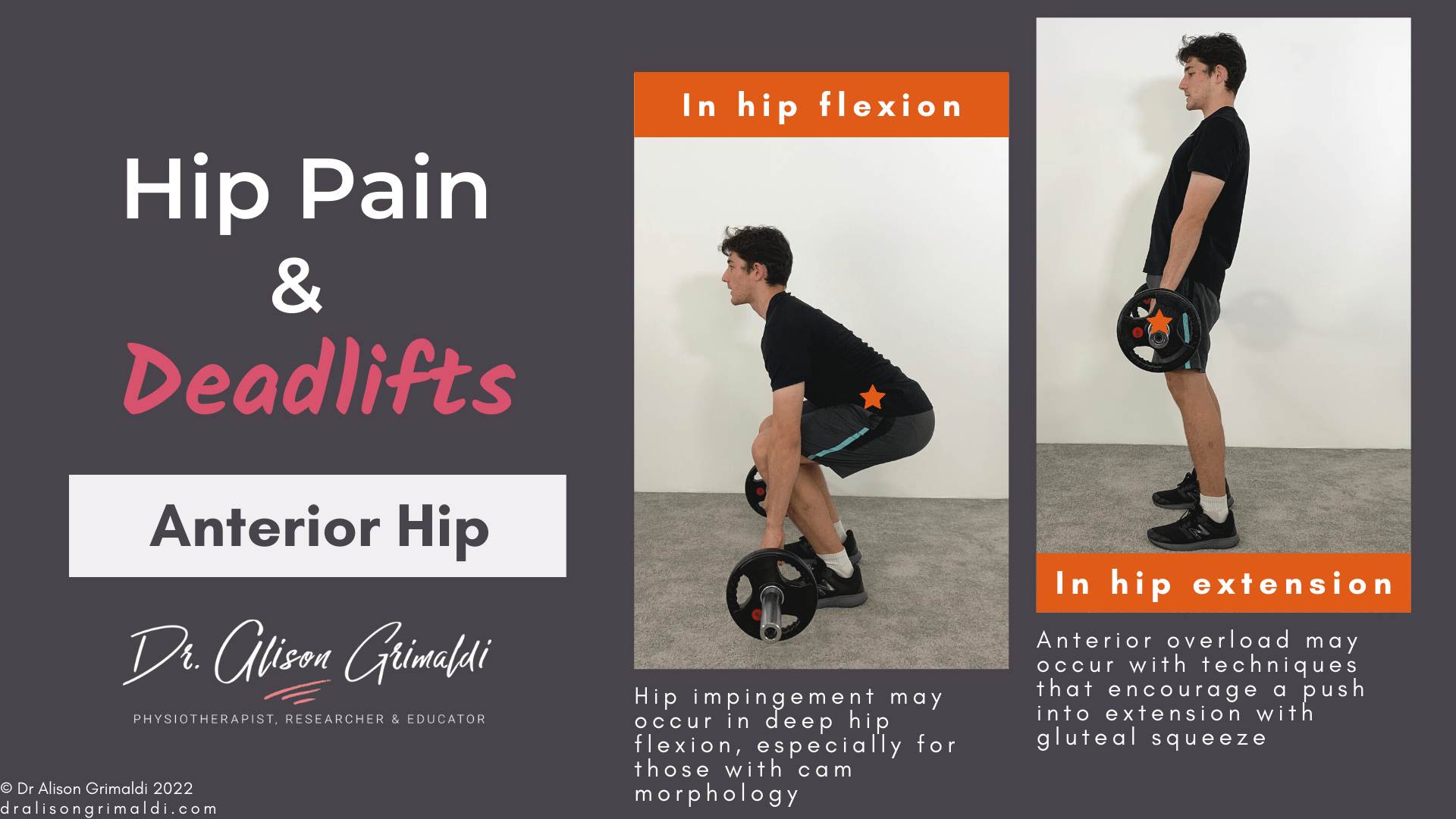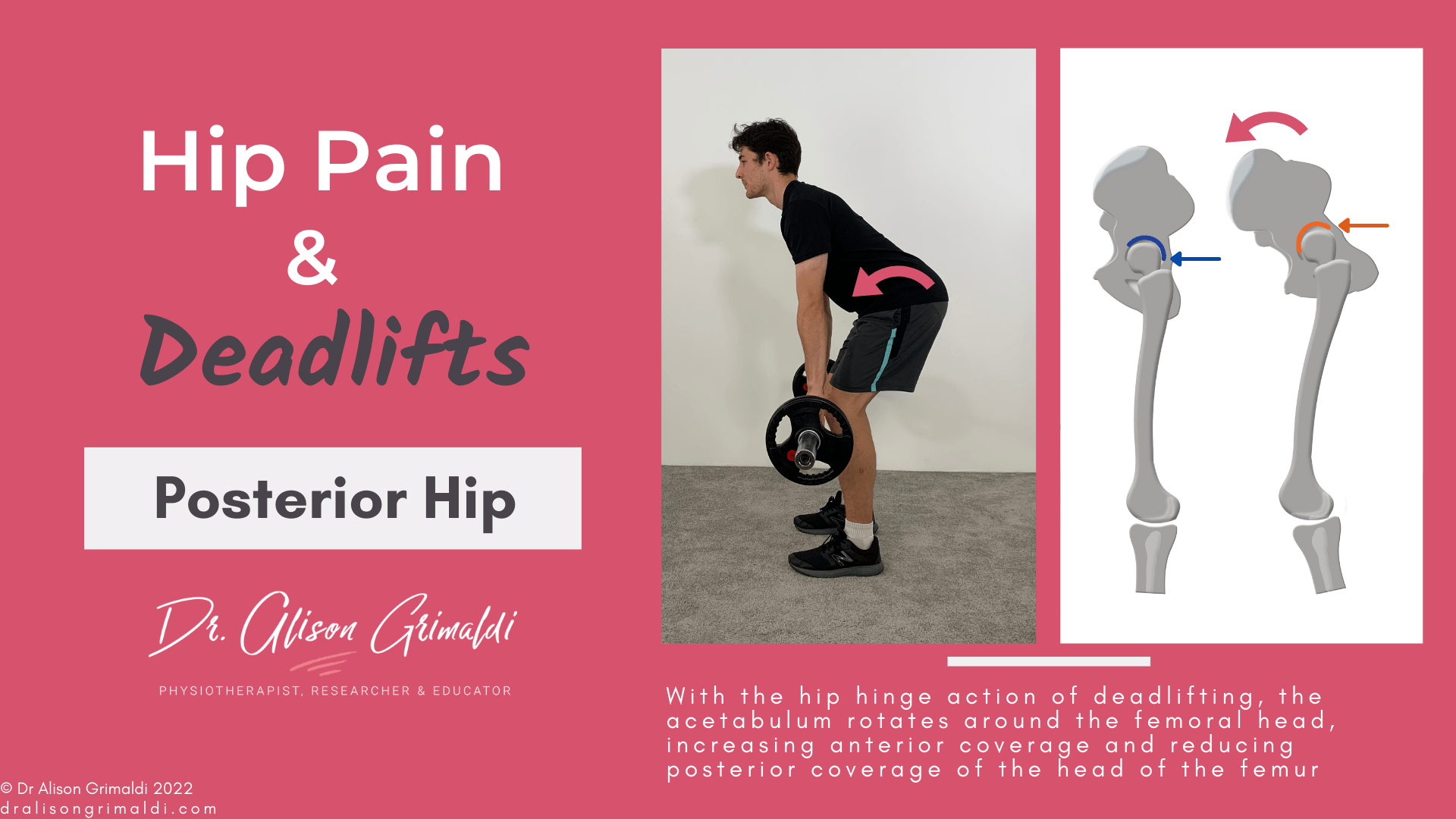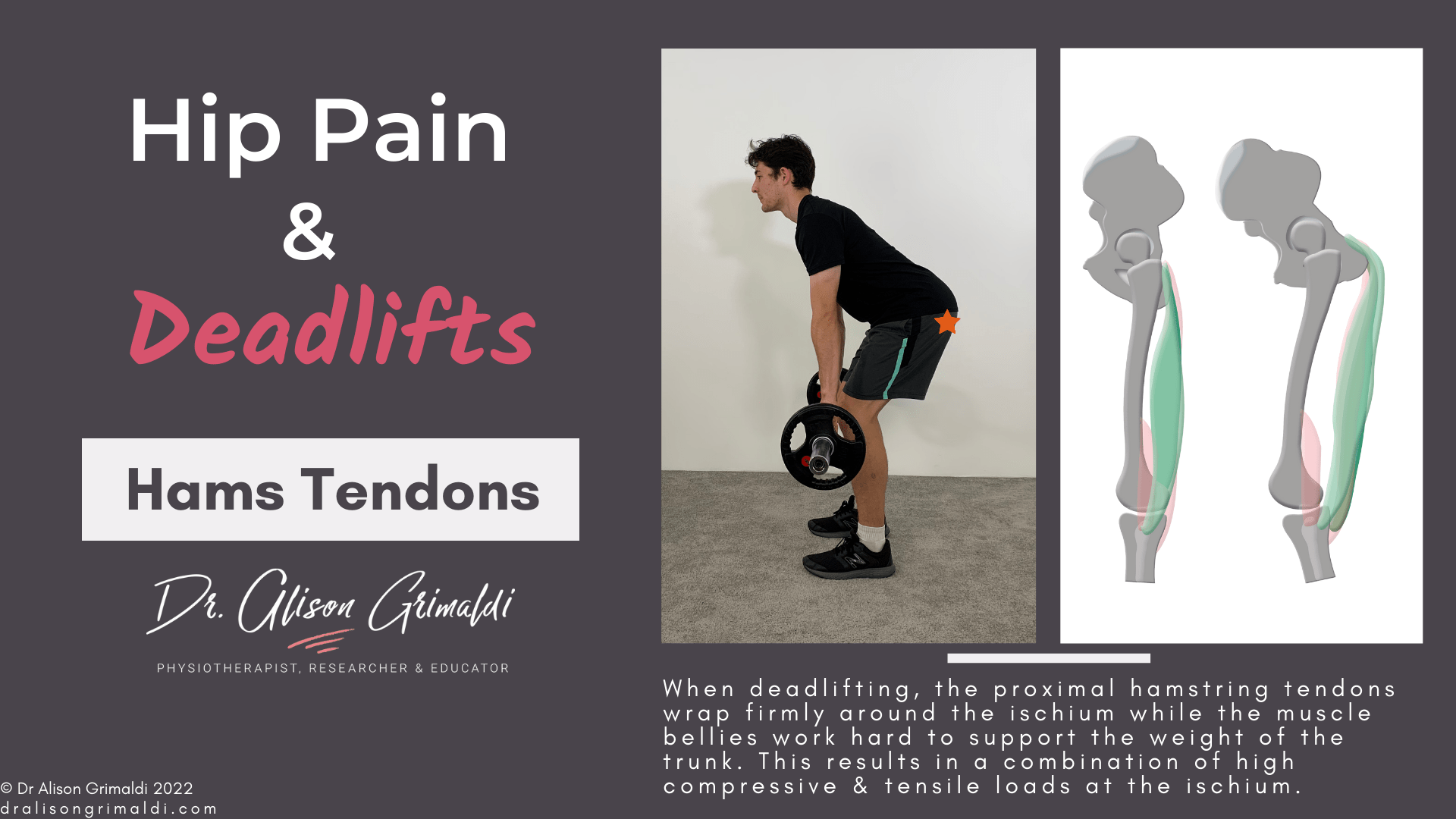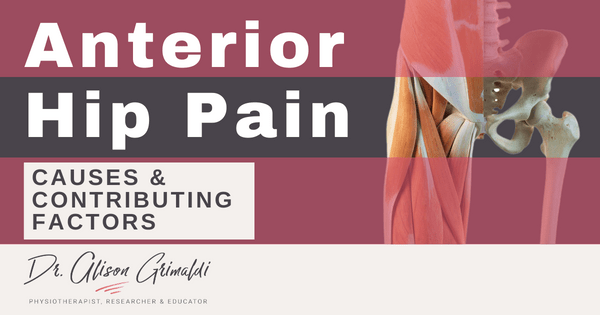Modifying Deadlifts for Hip Pain

Today we'll be continuing a 3-blog series focusing on modifying common gym exercises for hip pain. Our focus for this blog is deadlifting, which can be challenging and highly provocative for many with hip pain. Last year we kicked off with the Rearfoot Elevated Split Squat. Then we took an intermission to wrap up 2021 and for the 12 Hip days of Christmas in December. If you missed this 12 day series of miniblogs featuring top hip papers, you'll find them all back on the main blogpage. Now, back to deadlifts. This is one exercise that causes a lot of contention when it comes to backpain, but often the high loads placed across the hip joint and adjacent soft tissues by deadlifting can be overlooked. Not that this means deadlifts should be avoided. Deadlifts create some great stimulus through the trunk and lower limb extensors, but the technique and level of challenge needs to be appropriate for the individual. Technique will also impact on relative load sharing down the lower kinetic chain.1,2 It's important to be aware of the impact of deadlifts on the hip region, on some specific conditions and how to modify deadlifts for hip pain.
Deadlifts present a challenge for the hip
Deadlifts are most commonly performed as a hip-hinge action in standing with a free barbell. This exercise is performed for lower limb extensor strengthening, with the emphasis here on the hip extensors more than the knee extensors, and of course the trunk extensors are also loaded but our focus for this blog will be on the hip. For the hip region, the main challenges and potential sources of hip irritation are the range of motion, the effect of lever arm and the combination of hip flexion and knee extension, depending on particular technique.
Exacerbation of anterior hip pain in deadlifts
Anterior hip pain may be provoked at peak hip flexion and/or peak hip extension. With a traditional deadlift that involves lifting a barbell from the floor, the hips are in high ranges of hip flexion, which may give rise to impingement related issues. However, in a deadlift the pelvis is free to move. This means that those with limited hip range, for example due to FAI, may compensate by moving into more posterior pelvic tilt and lumbar flexion. If overload does occur then, pain may be experienced at the anterior hip or in the lumbopelvic region, depending on how load is transferred.
The other potential mechanism for aggravation of anterior hip pain is at the other end of the movement cycle, when returning to an upright position. Many gym trainers teach a hip extension thrust when returning to standing, which places large loads on the anterior hip joint and soft tissues. This is amplified by the concurrent cue to squeeze the gluteus maximus maximally during this terminal extension. The usefulness of this thrust from a training perspective is questionable, with the glute max mechanically disadvantaged at this point in range. There may be more risk than benefit in this cue, particularly for those with or at risk of anterior hip pain or injury.

Exacerbation of posterior hip pain in deadlifts
Compared to squat technique, the hip hinge action of the deadlift distributes higher loads to the hip and lower loads to the knee. This is very beneficial for targeted hip extensor strengthening. However, in certain situations this load may be intolerable.
Exacerbation of hip pain associated with posterior instability
Those with reduced posterior hip stability will often struggle with the deadlift action and may be at risk of significant injury if inappropriate loads are applied in this position. Posterior instability is more likely in those with:
- acetabular dysplasia
- acetabular retroversion
- previous trauma (posterior subluxation or dislocation)
- hypermobility spectrum disorders/EDS
- iatrogenic reduction in capsular integrity (posterior approach arthroplasty)
- femoroacetabular impingement.
The high challenge is inherently linked with trunk position, effect of gravity and long levers when lifting loads in this position. While reduced posterior stability is not so concerning in an upright position because the superior joint is absorbing the load, when the trunk inclines forward and the pelvis tips anteriorly, the load transmits to the posterior joint.
More anterior tilt of the pelvis = less bony coverage of the femoral head = greater reliance on posterior capsuloligamentous structures.
Adding a barbell to the hands at the end of the long lever of the trunk dramatically increases the challenge to the posterior joint. Pain provocation from this high challenge to the posterior joint, may be related to joint overload or, once again, to deep rotator overload +/- irritation of the adjacent sciatic nerve in those with deep gluteal syndrome. Sciatic nerve irritation in this situation is usually worse in the stiff-legged deadlift style, with higher levels of neural tension.

Exacerbation of hip pain associated with proximal hamstring tendinopathy
The action of the deadlift creates a hinge around the hip joint and a pulley around the ischial tuberosity, where the proximal hamstring tendons wrap firmly around the ischium. The combination of high levels of tendon compression and tensile loads from the highly active hamstring muscles,1 can be provocative for those with proximal hamstring tendinopathy and tears. Stiff legged styles will be more provocative due to higher hamstring loads. The decision around if, and when to reintroduce deadlifts for proximal hamstring tendinopathy is not simply about symptoms. Structural integrity of the hamstring tendons should be considered.

Modifying Deadlifts for Hip Pain
The main principles of avoiding exacerbation are around avoiding terminal range overload, but also controlling the lever arm and increasing load sharing with the knee. Use these tips to modify deadlifts to avoid exacerbation of hip pain:
- Reduce range of hip flexion and trunk inclination – lift from a rack rather than the floor
- Reduce lumbar lordosis/anterior pelvic tilt
- Choose bent-knee rather than stiff-legged styles
- Keep the weight as close to the thighs/shins as possible
- Stop the hip extension thrust
- Reduce weight and volume of training
We are not done yet with this series on modifying gym exercises. There is one more next month, so stay tuned. Sign up to our mailing list below if you don’t want to miss it!
Another great Anterior Hip Pain blog

Anterior Hip Pain: Causes & Contributing Factors
Adequate consideration of individual causes and contributing factors is important for best outcomes.
Sign up to our newsletter to receive updates on upcoming courses, news and special offers.
References
- Llurda-Almuzara, L., Labata-Lezaun, N., López-de-Celis, C., Aiguadé-Aiguadé, R., Romaní-Sánchez, S., Rodríguez-Sanz, J., Fernández-de-las-Peñas, C. and Pérez-Bellmunt, A., 2021. Biceps Femoris Activation during Hamstring Strength Exercises: A Systematic Review. International Journal of Environmental Research and Public Health, 18(16), p.8733.
- Martín-Fuentes, I., Oliva-Lozano, J. and Muyor, J., 2020. Electromyographic activity in deadlift exercise and its variants. A systematic review. PLOS ONE, 15(2), p.e0229507.

